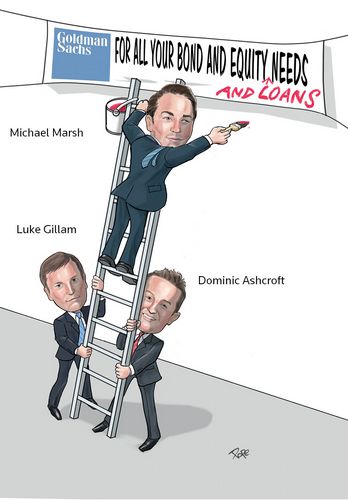Reaping the rewards
Leveraged loans took the limelight in 2017, and banks increased their focus on speculative-grade clients to maximise returns. For its relatively new enthusiasm for lending, backed up by a large balance sheet and an appetite for risk, Goldman Sachs is IFR’s EMEA Loan House of the Year.
In 2017 leveraged loans were on fire, reaching levels of activity not seen since the financial crisis.
Investors ploughed money into the product and borrowers showed a preference for the paper over high-yield bonds. Covenant-lite deals became the mainstay of the market, as did increasingly flexible documentation and compressed yields, all offered without restrictive non-call periods.
Goldman Sachs noted a shift in sentiment towards loans early on and made a concerted effort by increasing resources devoted to the area, leapfrogging some of the more traditional European commercial banks in the process and reaping the rewards of a growth plan that had been put into motion some four to five years previously.
“We especially focused on the loan product this year as we could see the demand increase and a tolerance for tighter spreads, and we used that to take ideas to clients,” said Dominic Ashcroft, co-head of EMEA leveraged capital markets.
The bank made structural shifts to enhance its loan offering, moving the CLO business from trading to the origination and capital markets unit. The CLO business grew dramatically in 2017 to around seven clients totalling €2.915bn from a single client in 2014, CVC, totalling €950m.
The structural change enabled Goldman bankers to see first-hand the increased liquidity for CLOs and the tightening of spreads that would flow into the loan product. A coordinated approach, facilitated by more loan traders and analysts, helped the bank take market share in the non-investment-grade space.
“There were a bunch of funds wanting to buy CLO equity and defaults were down. It led us to think that the loan product had room to run and we could test certain transactions and reprice and refinance them,” said Michael Marsh, head of EMEA leveraged finance.
Goldman used this to secure better terms for borrowers and supply new paper to investors through deals such as a €505m loan for Finnish insulation maker Paroc, which was used to refinance existing bonds and pay a dividend to shareholders.
With a pick-up in event-driven financings, Goldman took centre stage, acting as lead-left on several jumbo buyout loans. Those deals included the €1.45bn term loan for German building materials maker Xella, a €1.385bn term loan backing French smartcard maker Oberthur Technologies’ acquisition of Morpho and a €1bn term loan backing life sciences company Avantor’s buyout of lab supplies company VWR.
Goldman also took the lead on a variety of mid-sized and smaller financings, including a €765m term loan backing the merger of industrial supplies company IPH and its peer Brammer, and a €245m TLB for the buyout of Dutch chemical firm Caldic.
The bank was also a lead bank on a Poland’s largest-ever loan to support a sponsor-backed buyout. The Z5.14bn (US$1.43bn) deal for e-commerce business Allegro was also the first in the country to feature a second-lien tranche.
“Goldman tends to bring interesting stuff that is priced and executed well,” a senior investor said.
Goldman put its balance sheet to work, targeting low Double B and high Single B credits for returns of 250bp–350bp over Euribor, and also invested third-party funds managed by the bank into richly priced loans. This helped Goldman to win new clients and become a large lender to some of them, with investments of €100m tickets in certain instances.
“We have been actively deploying capital. Commercial banks have been shying away from covenant-lite products and have mainly stuck to where their relationships are and leverage is low. We do it to support clients and get a good return on the balance sheet,” Marsh said.
To increase market share was quite a feat against a backdrop of enhanced regulations, with the Federal Reserve’s leveraged lending guidelines acting as a handicap for US banks compared with their European counterparts, and low market volatility, which prompted fierce competition among banks for deals.
“The fact we maintained and grew our position in what we would see as a bank-friendly environment shows the improvement we have had in our loan franchise and its strength. We have been on the front foot of loans and taken market share,” Ashcroft said.
To see the digital version of this review, please click here.
To purchase printed copies or a PDF of this review, please email gloria.balbastro@tr.com.



